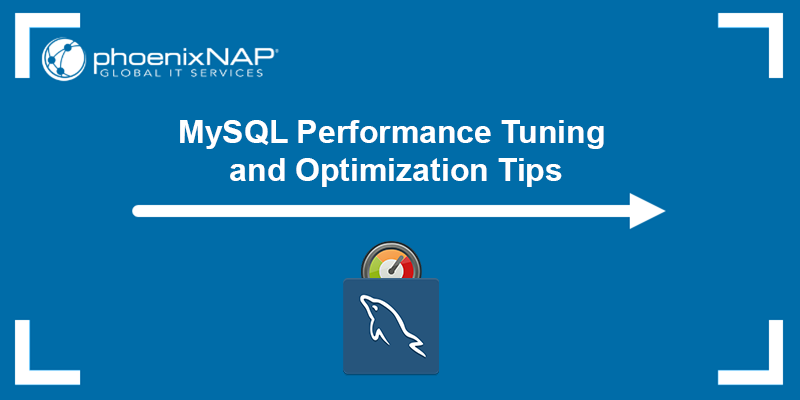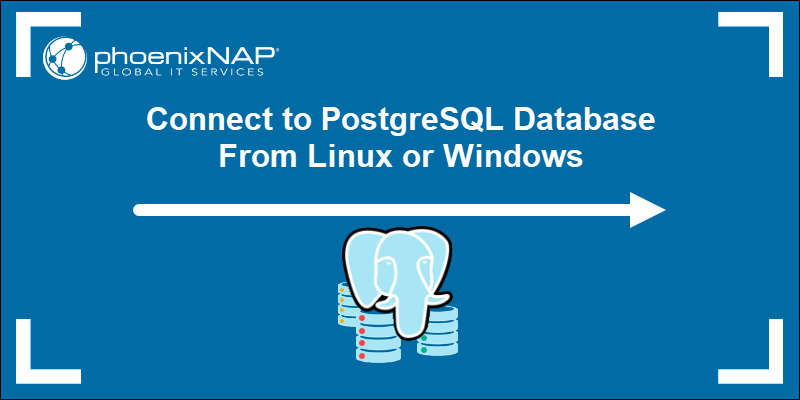Introduction
A Database Management System (DBMS) provides a front end for a database. This software solution provides a way to add, remove, retrieve, and control access to data in a database.
MySQL and PostgreSQL are the two most prominent open-source databases. The decision to use either one depends on specific use cases and requirements.
This article focuses on the main differences between MySQL and PostgreSQL.
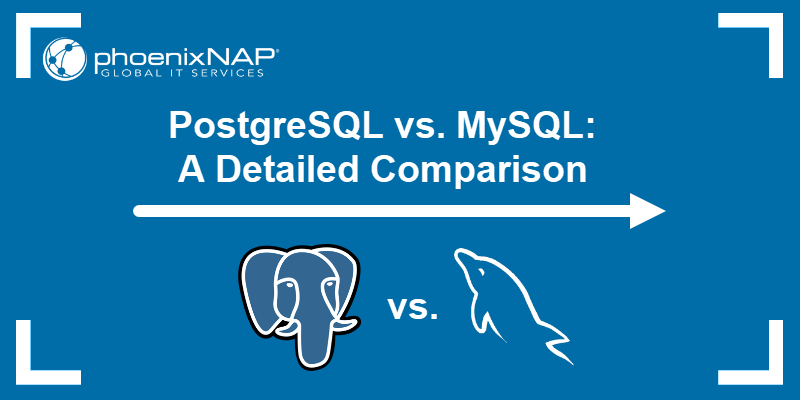
MySQL vs. PostgreSQL: Quick Overview
MySQL and PostgreSQL are continuously improved by an active community of contributors. This process reduces the differences between these two solutions over time.
However, there are significant contrasts that become evident in deployments with heavy workloads. Below is a brief comparison table between MySQL and PostgreSQL.
| MySQL | PostgreSQL |
|---|---|
| An open source and a paid commercial edition. | Open source and free. |
| Extremely fast and reliable. | Adaptable and feature-rich. |
| Focuses on speed rather than on fulfilling SQL standards. | Complies with most SQL standards. |
| Ideal for read-heavy workflows in web-based solutions. | Ideal for complex queries and massive databases. |
| MySQL bases its security features on Access Control Lists (ACLs). | PostgreSQL has in-built SSL support and the ability to encrypt client/server communications. |
| Has little support for NoSQL features. | Supports multiple NoSQL features. |
| InnoDB engine is ACID compliant. | Complete ACID compliance. |
| Limited support for extensibility. | It is possible to add new functions, types, index types, and other features. |
| Limited support for server-side programming in a non-extensible language. | PostgreSQL supports the most popular programming languages. |
| Supports deployment on Docker Containers. | Supports deployment on Docker Containers. |
Continue reading to see a more in-depth comparison between MySQL and PostgreSQL.
What is MySQL?
MySQL is one of the most popular Relational Database Management Systems (RDBMS). The system helps store, manage, and maintain large data volumes. MySQL is a popular choice for web development because it is flexible and reliable.
MySQL uses structured query language (SQL) to access and manage data in databases. Small, medium, and large-scale enterprises all use MySQL in their technology stacks.
Features of MySQL
MySQL is a feature-rich platform for database management. The system is available for Windows, Linux, and macOS. A large community base contributes to the constant development and support of MySQL.
Below is a brief analysis of some MySQL features.
Performance and Speed
MySQL aims to achieve speed and performance metrics for read-heavy operations. This metric is useful for simple information-sharing and read-based workflows in web solutions.
The simplicity of database deployment means that MySQL easily scales horizontally. Various MySQL techniques help improve query speeds. Methods such as indexing, database normalization, and table optimization, help improve database performance.
Note: Check out our tips to improve MySQL performance with system and MySQL performance tuning suggestions.
Licensing
MySQL comes with two different licensing options:
- General Public License (GPL). A free and open-source license that allows using and modifying the code. Any released changes require GPL.
- Commercial License. The closed-source license provides more functionalities. Organizations can release applications without GPL licensing. The license offers features and customer support not available in the free version.
Compliance
MySQL sacrifices some SQL compliance for speed and performance improvements. MySQL options allow choosing a working mode that respects the SQL standard.
ACID compliance for MySQL depends on the storage engine in use. The InnoDB engine is the default since MySQL version 5.5 with full ACID transaction support. The compliance is suitable for applications that need data integrity and consistency.
Syntax
MySQL uses several non-standard approaches in the SQL syntax. Some examples are:
- Comments. MySQL uses the standard double dash (
--) and the non-standard number sign (#) for single-line comments. The following two examples provide the same result:
-- This is a comment in MySQL
# This is also a comment in MySQL- Quotes. Double quotes (
") and single quotes (') are interchangeable. For example, the following two queries show the same result:
SELECT * FROM db WHERE company='phoenixNAP';SELECT * FROM db WHERE company="phoenixNAP";Additionally, MySQL also uses backticks (`) for quoting system identifiers. For example:
SELECT * FROM `db`;- Logical operators. MySQL utilizes C-style logical operators, which is not typical for database syntax. For example, the double bar (
||) is an OR operator, whereas the operator is typically used for string concatenation. - Case sensitivity. MySQL is not case-sensitive. Queries do not need to match strings as they are written in the database to find a match. For example, the following two statements match the same data:
SELECT * FROM db WHERE company='phoenixnap';SELECT * FROM db WHERE company='phoenixNAP';Notes: Grab our free MySQL commands cheat sheet in PDF format.
Security
MySQL features various authentication methods to protect the database from threats. Some examples include passwords, certificate-based authentication, and public key authentication. Additionally, MySQL offers TLS and SSL encryption for confidential data.
Access control mechanisms, such as users, roles, and groups, control object and database access. Various logging mechanisms provide a method to track all database activities.
GUI
The MySQL graphical user interface (GUI) is called MySQL Workbench. The tool enables development, administration, database design, and maintenance in a single environment.
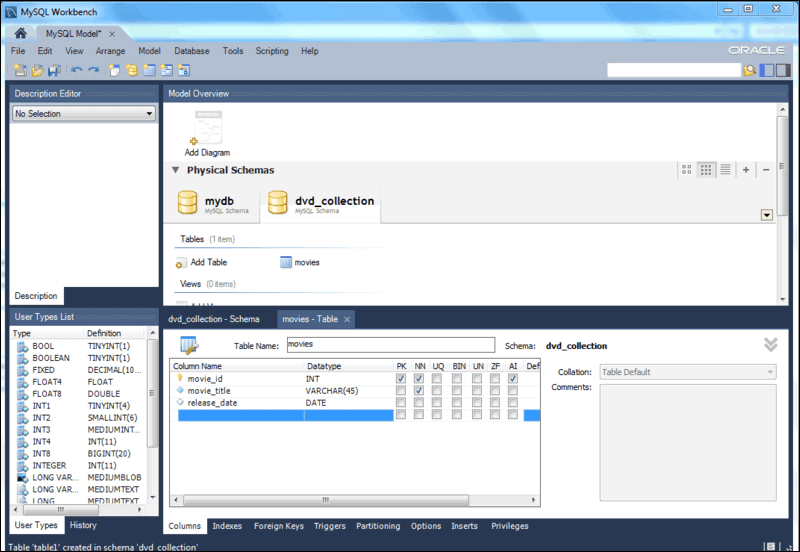
The program allows managing a database through a GUI. Notable features include an SQL editor, data modeling tools, and database migration mechanisms.
Data Types
MySQL data types are unique and help ensure the optimization of database tables. Some examples of how different data types behave in MySQL are:
- Booleans. MySQL does not have a Boolean (bool) type. Instead, it uses
TINYINT(1)orBIT(1)to represent Booleans. - Auto-increments. MySQL uses the
AUTO_INCREMENTattribute on integer fields (INTorBIGINT). - Dates and time. Several functions help represent the time and date in MySQL. For example,
DATETIME/TIMESTAMP,DATE,TIME, andYEAR. MySQL date and time functions help perform various calculations using these data types.
Concurrency
Concurrency allows applications or users to use the database at the same time. Some MySQL mechanisms that help handle concurrency are:
- Granular locking. MySQL supports row-level, table-level, and page-level locking mechanisms. The locking helps prevent conflicting transactions and ensure data consistency.
- Transaction isolation. Different transaction levels define interactions when reading and writing data at the same time.
- Deadlocks. A deadlock mechanism in MySQL detects and rolls back a transaction when two actions happen at the same time.
Replication
The MySQL replication process creates one or more copies of a database. The redundancy provides a disaster recovery mechanism. Notable features of MySQL replication are:
- Topologies. Various replication topologies have different benefits depending on the use case. Example topologies include master-slave, master-master, and circular replication.
- Filters. MySQL allows custom replication filters. The filters control which tables or databases replicate. As a result, the replication traffic lowers and reduces data redundancy.
- Methods. Statement-based replication (SBR) copies statements. Row-based replication (RBR) replicates row changes in a master-slave configuration.
- Modes. MySQL offers two replication modes. Asynchronous mode commits transactions without waiting for confirmation from the slave node. Semi-asynchronous waits for confirmation before committing a transaction.
Use Cases of MySQL
MySQL is a common backend database system for web applications. The DBMS is part of both the LAMP and WAMP stack. The high-performance capabilities and scalability make MySQL suitable for various use cases. Some examples include e-commerce websites, social media platforms, data warehousing, and website hosting.
MySQL is a versatile system that works for both small businesses and large-scale businesses. Some notable use cases include Facebook, GitHub, and Shopify.
What is PostgreSQL?
PostgreSQL is an open-source object-relational database management system (ORDBMS). The DBMS combines relational database principles with an object-oriented database model.
The database management system is extensible, reliable, and robust. Both small and large businesses use PostgreSQL.
Features of PostgreSQL
PostgreSQL contains many features to manage data, performance, and security. PostgreSQL has a large user base and works on Linux, macOS, and Windows.
Continue reading to see a detailed overview of different PostgreSQL features.
Performance and Speed
PostgreSQL performs complex operations on large datasets by design. The DBMS excels with advanced queries, read-write analysis, and administering large databases.
For best performance and speed results, the database server requires reliable hardware. The cache size, working memory, and shared buffers are all adaptable, so you can configure PostgreSQL parameters depending on your use case. The custom parameters help optimize the database system to meet specific requirements.
Licensing
PostgreSQL is open-source and free to use. The source code is available for copying, changing, and redistribution.
The open-source approach creates a vibrant community of developers. PostgreSQL receives constant development improvements and new solutions as a result.
Compliance
PostgreSQL focuses on compliance with SQL standards. The emphasis on industry standards makes this DBMS portable and easy to integrate with different tools.
PostgreSQL is ACID compliant. The DBMS contains mechanisms for transaction management, multi-version concurrency control (MVCC), and write-ahead logging (WAL).
Syntax
PostgreSQL uses conventional SQL command and statement syntax. Some examples include:
- Comments. PostgreSQL uses only the standard double dash (
--) for comments. For example:
-- This is a commentThe comment begins after the double-dash and continues until the end of the line.
- Quotes. Single quotes (
') in PostgreSQL delimit string literals. For example:
SELECT 'String';Double-quotes (") delimit system identifiers, for example:
SELECT * FROM "db";- Logical operators. PostgreSQL uses standard logical operators (
AND,OR, andNOT) to evaluate Boolean expressions. Combinations of logical operators create complex expressions. - Case sensitivity. By default, PostgreSQL is not case-sensitive for system identifiers. However, using double quotes changes the behavior and makes identifiers case-sensitive. For example, the following two queries are different:
SELECT * FROM db WHERE company="phoenixnap";SELECT * FROM db WHERE company="phoenixNAP";Note: See our detailed guide on using the SELECT statement in PostgreSQL.
Security
PostgreSQL has advanced security features to protect database access. The DBMS allows custom authentication methods, passwords, Kerberos, LDAP, and certificate-based authentication. SSL encryption secures client-server communication, while extensions provide data-at-rest encryption.
User roles create detailed access control for every database object. PostgreSQL enables changing row-level access based on user roles using commands such as GRANT and REVOKE.
Note: See how to create a user in PostgreSQL.
GUI
The GUI for PostgreSQL is pgAdmin4. The simple interface enables performing complex tasks and eases database management.
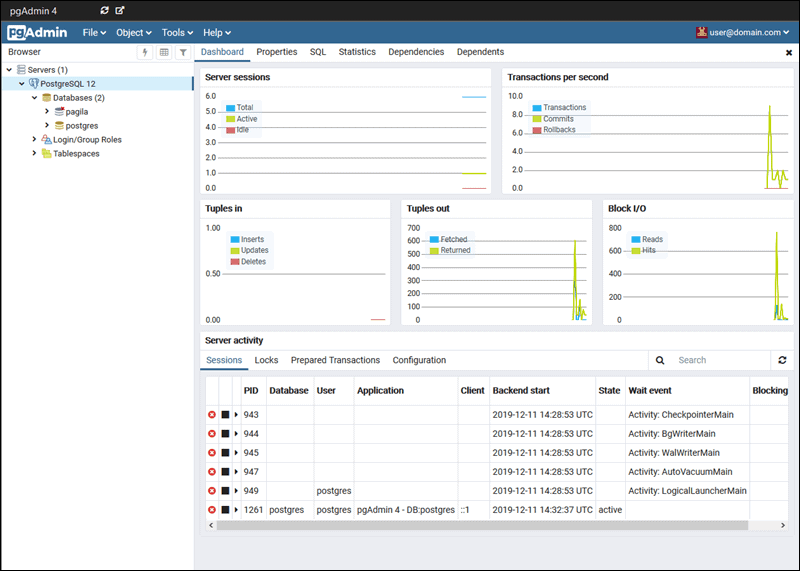
As PostgreSQL focuses on extensibility, pgAdmin4 allows adding various enhancements and management features.
Data Types
PostgreSQL features standard SQL data types, along with some unique types. Distinct data types in PostgreSQL are:
- Range. PostgreSQL supports creating range types for integers, decimals, and dates. Apart from built-in ranges, custom ranges for other data types are also available.
- Array. PostgreSQL allows storing columns and databases as multidimensional array types.
- JSON. PostgreSQL provides advanced indexing and querying for JSON data types.
- Boolean. Built-in Boolean data type with
boolorbooleankeywords.
For more details, check out our in-depth PostgreSQL data types overview.
Concurrency
PostgreSQL achieves a high level of concurrency. Several mechanisms exist to handle concurrency in PostgreSQL, such as:
- MVCC (Multi-Version Concurrency Control). The mechanism allows simultaneous read/write transactions without interruptions. Every transaction has a snapshot of the database at a specific time to avoid conflicts.
- Locking. A locking mechanism assures that two transactions do not change the same row. When a transaction makes a change, the row locks until the change applies. The lock prevents other transactions from making modifications.
- Conflict resolutions. Mechanisms for conflict resolutions ensure data consistency. For example, transaction serialization enables executing transactions one by one. If any transaction fails, the system reattempts the execution.
Replication
Replication ensures a PostgreSQL database has high availability and scalability. Database copies help increase fault tolerance and prevent data loss. PostgreSQL supports different replication types, such as:
- Logical replication. Replicates changes made to specific tables or rows instead of the whole database.
- Streaming replication. The replication process copies all changes made in a main database to one or more alternate databases. The standby databases are used for read-only queries or they can become primary databases in case of failure.
Other third-party replication methods exist for PostgreSQL with advanced features, such as multi-master replication or replicating stored procedures.
Use Cases of PostgreSQL
PostgreSQL is one of the most popular open-source database management systems. The database system finds a wide range of applications, including web development, mobile applications, scientific research, data warehousing, and others.
High performance, complex query support, and data integrity make PostgreSQL popular among web developers, organizations, and researchers. Some notable use cases include Instagram and Etsy.
MySQL vs PostgreSQL: Which One Should You Use?
Both MySQL and PostgreSQL are popular open-source database management systems with unique features. Choosing between the two depends on the specific requirements for a project and a database administrator's experience.
MySQL provides performance, speed, and ease of use as primary features. If your use case consists of simple queries and data types, MySQL is the superior choice.
On the other hand, choose PostgreSQL if data integrity, extensibility, and ACID compliance are important. The DBMS performs better with complex queries and includes advanced data types, which are better suited for analytics.
Both database systems are well documented and have a large and active community for support and development.
Conclusion
This article provided insight into the main differences between PostgreSQL and MySQL. Now you have a good idea of which DBMS is more suitable for your use case.
If you are interested in NoSQL alternatives to MySQL and PostgreSQL, check out our article on Cassandra vs. MongoDB. Alternatively, see how MySQL compares to MongoDB.
